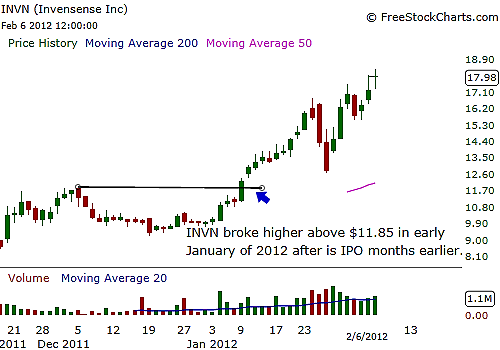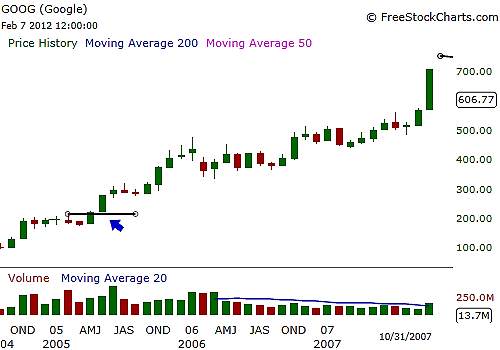
HOT TOPICS LIST
- MACD
- Fibonacci
- RSI
- Gann
- ADXR
- Stochastics
- Volume
- Triangles
- Futures
- Cycles
- Volatility
- ZIGZAG
- MESA
- Retracement
- Aroon
INDICATORS LIST
LIST OF TOPICS
PRINT THIS ARTICLE
by Billy Williams
Initial public offerings generate a lot of buzz like the upcoming IPO for Facebook, and if you know this trading method, you could stand to earn a lot of money.
Position: Hold
Billy Williams
Billy Williams has been trading the markets for 27 years, specializing in momentum trading with stocks and options.
PRINT THIS ARTICLE
STRATEGIES
How To Trade IPOs
02/10/12 10:59:06 AMby Billy Williams
Initial public offerings generate a lot of buzz like the upcoming IPO for Facebook, and if you know this trading method, you could stand to earn a lot of money.
Position: Hold
| Initial public offerings (IPOs) occur when an existing business operation sells shares to the public through a stock exchange in order to raise operating capital as well as offer an exit for any early investors of the company's inception, such as venture capitalists. For the astute trader, IPOs offer solid opportunities for bankable trades as the market for a stock is being made during the launch of the shares on an exchange but without the early volatility that typically takes place during the first days of the IPO. First, it's important to understand why companies would want to take on the enormous amount of red tape that comes with offering its shares to the public. While many successful businessmen like Richard Branson, for example, have frowned on taking private companies public due to the fickle nature of the valuation of the shares as well as the tremendous oversight by the Securities & Exchange Commission (SEC) and other federal agencies, taking a company public allows it to use its stock as a type of currency while it grows. See Figures 1 and 2. |

|
| FIGURE 1: INVN. INVN had an IPO in the latter part of 2011 and rose rapidly during the initial buzz but then drifted lower as things died down. After a while, price rose by almost 50% with the potential to go even higher. |
| Graphic provided by: www.freestockcharts.com. |
| |
| When a company is trying to grow, it can accomplish doing so in one of two ways. One, it can grow through steady sales growth and aggressive positioning in its market, which is the most commonly thought-of way on how a business grows or, two, it can grow through acquisition or through buying other existing businesses that complement its business model. "Growing" a company in the traditional sense can be painfully slow and extremely difficult if there is a lot of competition, so for companies that are looking to aggressively expand, then just buying another business that has already done the heavy lifting is the fastest and easiest way to gain a competitive advantage without having to start from scratch. And companies that have shares traded on the open market can use those shares as a type of currency to buy an existing business by offering shares in lieu of cash or a combination of both. |

|
| FIGURE 2: GOOG. In 2004, Google had its IPO accompanied by a lot of fanfare. After trading higher for several months, Google drifted lower, offering a buy entry as it resumed its uptrend past the $217 price level to trade as high as $707, tripling in price before a major pullback. |
| Graphic provided by: www.freestockcharts.com. |
| |
| For the seller, there are tax benefits from accepting the shares, and if the company being acquired is well run and believed to be a long-term player with growth potential, then that makes it a lucrative deal and a win-win for both parties. However, when a stock is taken public, especially on a company that is closely followed by the business media, like, say, Facebook, then the early days and weeks of trading can be extremely volatile. But when all the early fanfare and hype have subsided, as well as the buying frenzy of traders and investors who don't want to miss out on a potential windfall, the stock begins to settle into a smoother transition of price action and a potential trade setup for the astute trader. |
| What you want to do is to sit on the sidelines in order to bypass all the volatility; that type of price action is manic with no rhyme and reason, as it reflects the extreme emotional elements of the traders and investors who are looking to make a killing. Later, after the frenzied buying subsides, doubt begins to creep in, resulting in a dip in price as buyers' remorse sets in and causes the stock to enter a period of contraction. |
| After four to eight weeks, price will stabilize and begin to trade upward again, which is where you want to be ready to enter as price rises through overhead resistance. Place buy orders at the previous price highs and then ride the momentum to relatively easy gains of 20% to 100% or more. It's an easy setup with a lot of upside potential that capitalizes on traders with short-term attention spans as well as those looking to get a quick buck but lack a plan of action to translate those desires into a reliable and bankable method and leave them at the mercy of a trader who does. |
Billy Williams has been trading the markets for 27 years, specializing in momentum trading with stocks and options.
| Company: | StockOptionSystem.com |
| E-mail address: | stockoptionsystem.com@gmail.com |
Traders' Resource Links | |
| StockOptionSystem.com has not added any product or service information to TRADERS' RESOURCE. | |
Click here for more information about our publications!
PRINT THIS ARTICLE

|

Request Information From Our Sponsors
- StockCharts.com, Inc.
- Candle Patterns
- Candlestick Charting Explained
- Intermarket Technical Analysis
- John Murphy on Chart Analysis
- John Murphy's Chart Pattern Recognition
- John Murphy's Market Message
- MurphyExplainsMarketAnalysis-Intermarket Analysis
- MurphyExplainsMarketAnalysis-Visual Analysis
- StockCharts.com
- Technical Analysis of the Financial Markets
- The Visual Investor
- VectorVest, Inc.
- Executive Premier Workshop
- One-Day Options Course
- OptionsPro
- Retirement Income Workshop
- Sure-Fire Trading Systems (VectorVest, Inc.)
- Trading as a Business Workshop
- VectorVest 7 EOD
- VectorVest 7 RealTime/IntraDay
- VectorVest AutoTester
- VectorVest Educational Services
- VectorVest OnLine
- VectorVest Options Analyzer
- VectorVest ProGraphics v6.0
- VectorVest ProTrader 7
- VectorVest RealTime Derby Tool
- VectorVest Simulator
- VectorVest Variator
- VectorVest Watchdog
